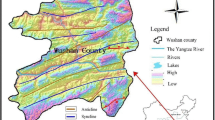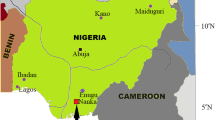Abstract
Based on detailed field data from recent geo-hazards surveys in the Loess Plateau region of western China, this study analyzes the key factors that control loess landslides. The evolution phase of river valleys, the geological structure of slopes and the geometry of slopes are all found to play a role in determining the occurrence, distribution and other characteristics of loess landslides. Groundwater and vegetation also contribute to their formation. A combination of human engineering activities and precipitation events are the principal triggering factors for the instability of loess slopes.












Similar content being viewed by others
References
Duan Y et al (1993) Geo-hazards in China (1st version). China Construction Industry Press, Beijing
Hydrogeological Team No. 2 (2000) Shaanxi Geological Bureau. Regional Environmental Geological Survey Report of Shaanxi Province
Hydrogeological Team 908 (2000) Shaanxi Geological Bureau. Landslides Survey Report of Baota Mountain, Yan’an City, Shaanxi Province
Lei X (2001) Human activities and geo-hazards on the Loess Plateau. Geological Press, Beijing
Liu D (1985) Loess and environment. Scientific Press, Beijing
Peng J (1997) Study of the stability of engineering field. Xi’an Cartographic Press, Xi’an
Sun J (2005) Loess sciences (1st version). Hong Kong Archaeology Association, Hong Kong
Wang J (1992) Mechanism of high speed loess landslides—saturated loess creeping liquefaction. Geol Rev 38(6):532–539
Wang S, Dai F (1997) Evaluation and prediction of engineering geoenvironment and countermeasures to coordinate human engineering activities. J Geol Hazards Environ Preserv 8(1):31–35
Wang Z, Wang N (2004) A summary of present study on loess landslides. Soil Water Conserv China (SWCC) 11:16–18
Yin Y (1996) Prediction and mapping of geo-hazards trend in China. Quat Study (2): 123–130
Zhang Z (1994) Typical human engineering activities and the impact on geological environment. Southwest Transportation University Press, Chengdu
Zheng Y (2002) Finite element strength reduction method and its application on soil and rock slope. Collected paper of Rock Mechanics and Engineering Society
Acknowledgments
The authors would like to thank the funding support from the National Land Resources Survey Project (1212010541106-3, 1212010740907) and the National Scientific Support Project (2006BAC04B05). The authors also greatly appreciate the help in field survey and data collection from Xiao Peixi, Wei Xingli, Huang Yuhua, Nie Haogang, Wang Jiayun, Wu Wenying, Li Lin, Sun Qiaoyin, Zhang Rui, Li Qing, Wang Xiaoyong, Zeng Lei, Xue Qiang and Yi Hao. Professor Lin Zaiguan provided valuable suggestions and great help in editing this paper.
Author information
Authors and Affiliations
Corresponding author
Rights and permissions
About this article
Cite this article
Zhang, M., Liu, J. Controlling factors of loess landslides in western China. Environ Earth Sci 59, 1671–1680 (2010). https://doi.org/10.1007/s12665-009-0149-7
Received:
Accepted:
Published:
Issue Date:
DOI: https://doi.org/10.1007/s12665-009-0149-7




